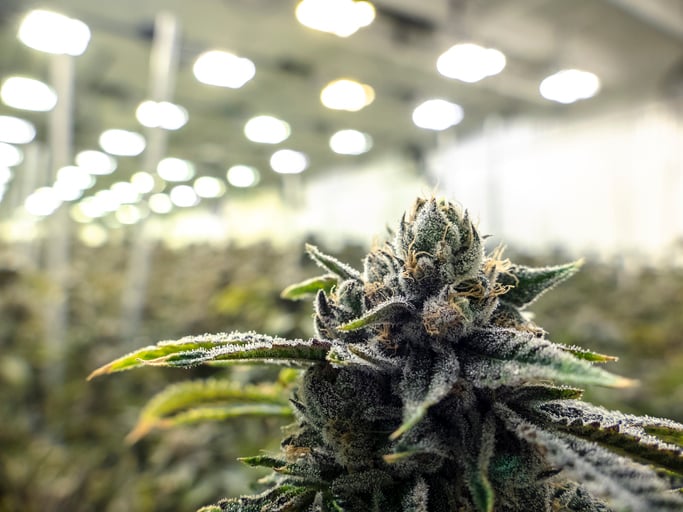Move over, spring! There's a different type of green that's captivating America, and its name is cannabis.
Just a few years ago, the marijuana industry was considered taboo throughout much of North America and the world. But as of today, more than 40 countries worldwide have now legalized medical cannabis in some capacity, with Canada becoming the first industrialized country in the world to OK recreational weed this past October. Within the U.S., where marijuana remains an illicit substance at the federal level, 33 states have chosen to legalize the drug for medical purposes, with support for legalization among the public higher than it's ever been.
Marijuana has turned into a generational growth story, and investors simply don't want to miss out.

Image source: Getty Images.
Canopy Growth is in pole position in the cannabis space
Leading the charge for pot stocks is Canopy Growth (CGC +6.06%), which is the only large-cap, pure-play cannabis company.
Canopy has a lot working in its favor, including 5.6 million square feet of cultivation space that should allow it to produce more than 500,000 kilograms of cannabis at peak capacity. Superior sales channels and branding, along with a healthy overseas presence, aren't hurting either.
But what's arguably been the company's biggest aid is the $4 billion equity investment it received from Corona and Modelo beer producer Constellation Brands (STZ 1.77%). The equity investment, which closed in November, was the third time since October 2017 that Constellation had directly or indirectly invested into Canopy Growth. The share issuance pursuant to the investment gave Constellation a 37% stake in Canopy, with the option of upping its stake to 56% if it chooses to exercise the bounty of warrants it also received.
Inclusive of a few acquisitions late in 2018 and normal operating expenses, Canopy Growth ended 2018 (the calendar year, not Canopy's fiscal year) with cash, cash equivalents, and marketable securities that totaled nearly $3.7 billion.

Image source: Getty Images.
Here's how Canopy will put its billions of dollars in cash to work
Obviously, Canopy isn't going to sit on its hands while the cannabis industry evolves at a fast pace. Rather, you can expect the company to put this money to work in a variety of ways.
Check out the latest earnings call transcript for Canopy Growth.
1. Enter the U.S. market
If there were a top priority on Canopy Growth's list of things to do with its cash, entering the U.S. market has to be it. But as co-CEO Bruce Linton has opined in the past, his company won't enter countries where federal law is prohibitive.
Rather than focusing on cannabis production, Canopy is angling to get its foot in the door following the passage of the Farm Bill in December. The Farm Bill legalized hemp and hemp-derived cannabidiol (CBD)-based products. CBD is the nonpsychoactive cannabinoid best known for its perceived medical benefits.
In mid-January, the company was awarded a hemp producing and processing license by New York State. Canopy announced its intention to spend between $100 million and $150 million to develop a hemp processing facility in the southern tier of New York State. Since hemp-derived CBD bears a higher price point than dried cannabis flower, products containing CBD are often high margin and heavily touted by manufacturers.
In addition to being awarded a New York hemp production and processing license, Canopy Growth acquired hemp-research company ebbu brands in November, which brought a rich portfolio of intellectual property into its fold, and announced last week that it was buying AgriNextUSA to push into new markets beyond New York State. Though the hemp market pales in size to the pot market in the U.S., it nevertheless allows Canopy to get its foot in the door and establish relationships that could come in handy should the U.S. federal government change its tune on pot.

Image source: Getty Images.
2. International expansion
As is the case with most brand-name growers, you can expect Canopy to place a heavy emphasis on pushing further into overseas markets. With more than 40 countries having legalized medical marijuana access to some degree, opportunity is budding for Canopy Growth to diversify its revenue stream from a geographic perspective.
More so than just diversifying its revenue stream, Canopy Growth also needs to prepare for what's likely a coming glut of cannabis in its home market of Canada. Having already issued 159 licenses and permits, Health Canada has more than 800 additional license applications (mostly for cultivation) in its backlog. The Canadian market won't be able to support this many growers, likely leading to a rampant oversupply of dried flower within the next two years. Without avenues to offload excess supply, growers could struggle as per-gram dried weed prices plunge.
For its part, Canopy Growth has done a good job of pushing into more than a dozen markets. These overseas markets will serve as outlets where the company can offload excess domestic supply. Between economies of scale and it international markets, Canopy should be able to withstand even a sharp decline in per-gram pot prices.

Image source: Getty Images.
3. Product development and brand building
Investors can also expect Canopy Growth to put its $3.7 billion in cash to work by diversifying its product line and building up its existing brands.
As noted, there's a very good likelihood that dried cannabis flower will become commoditized in the not-so-distant future. This means Canopy is incentivized to diversify its portfolio of products to include higher-margin alternative products.
As an example, Constellation Brands and Canopy Growth are expected to work on a line on nonalcoholic cannabis-infused beverages, which should be legal in Canada by this coming October. But what you may not realize is that Canopy has already been working on a calorie-free, long-shelf-life, scalable beverage model for more than two years. The addition of Constellation to its existing work is just icing on the cake.
Mind you, this doesn't even speak to the company's growing intellectual property and patent portfolio, some of which was acquired when it purchased ebbu in November.
As for branding, Canopy Growth already has the most recognized pot brand in the country with Tweed. But that doesn't mean its work stops there. The company will be reinvesting capital into marketing new recreational products to boost consumer engagement.

Image source: Getty Images.
4. Acquisitions
Finally, regardless of whether Canopy Growth received an equity investment from Constellation Brands or not, it was going to make inorganic growth part of its long-term strategy. Having somewhat recently acquired Hiku brands and ebbu, it's pretty clear that Canopy aims to use its cash to further its push into the U.S. or international markets. While it's impossible to know what company Canopy is eyeing next, it's a near-certainty that, given its appetite for a few acquisitions a year, more buyouts are on the way.
The big question left to ask is, will Canopy's imminent spending spree yield the desired results? Only time will give us that answer.







